Paper Menu >>
Journal Menu >>
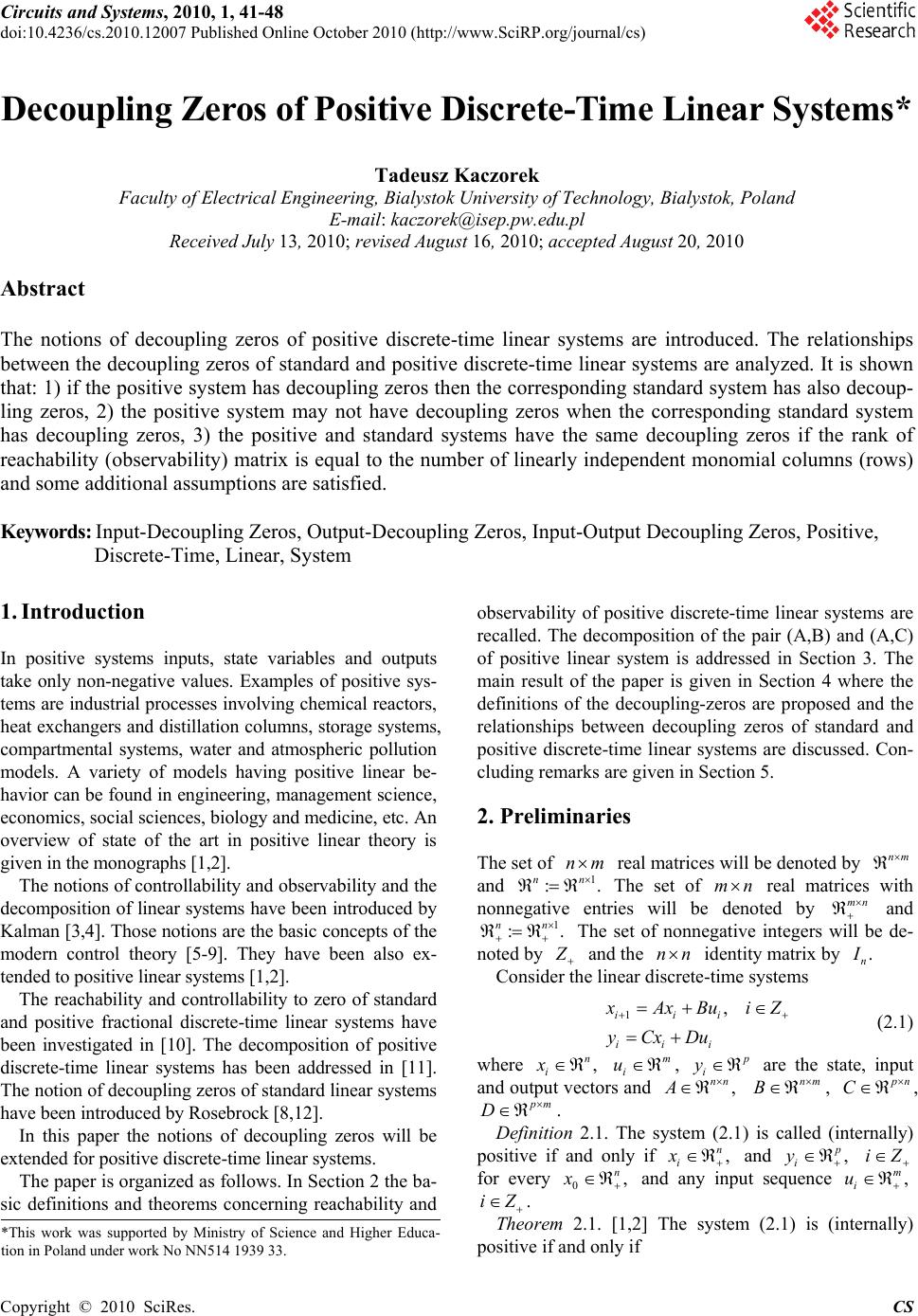 Circuits and Systems, 2010, 1, 41-48 doi:10.4236/cs.2010.12007 Published Online October 2010 (http://www.SciRP.org/journal/cs) Copyright © 2010 SciRes. CS Decoupling Zeros of Positive Discrete-Time Linear Systems* Tadeusz Kaczorek Faculty of Electrical Engineering, Bialystok University of Technology, Bialystok, Poland E-mail: kaczorek@isep.pw.edu.pl Received July 13, 2010; revised August 16, 2010; accepted August 20, 2010 Abstract The notions of decoupling zeros of positive discrete-time linear systems are introduced. The relationships between the decoupling zeros of standard and positive discrete-time linear systems are analyzed. It is shown that: 1) if the positive system has decoupling zeros then the corresponding standard system has also decoup- ling zeros, 2) the positive system may not have decoupling zeros when the corresponding standard system has decoupling zeros, 3) the positive and standard systems have the same decoupling zeros if the rank of reachability (observability) matrix is equal to the number of linearly independent monomial columns (rows) and some additional assumptions are satisfied. Keywords: Input-Decoupling Zeros, Output-Decoupling Zeros, Input-Output Decoupling Zeros, Positive, Discrete-Time, Linear, System 1. Introduction In positive systems inputs, state variables and outputs take only non-negative values. Examples of positive sys- tems are industrial processes involving chemical reactors, heat exchangers and distillation columns, storage systems, compartmental systems, water and atmospheric pollution models. A variety of models having positive linear be- havior can be found in engineering, management science, economics, social sciences, biology and medicine, etc. An overview of state of the art in positive linear theory is given in the monographs [1,2]. The notions of controllability and observability and the decomposition of linear systems have been introduced by Kalman [3,4]. Those notions are the basic concepts of the modern control theory [5-9]. They have been also ex- tended to positive linear systems [1,2]. The reachability and controllability to zero of standard and positive fractional discrete-time linear systems have been investigated in [10]. The decomposition of positive discrete-time linear systems has been addressed in [11]. The notion of decoupling zeros of standard linear systems have been introduced by Rosebrock [8,12]. In this paper the notions of decoupling zeros will be extended for positive discrete-time linear systems. The paper is organized as follows. In Section 2 the ba- sic definitions and theorems concerning reachability and observability of positive discrete-time linear systems are recalled. The decomposition of the pair (A,B) and (A,C) of positive linear system is addressed in Section 3. The main result of the paper is given in Section 4 where the definitions of the decoupling-zeros are proposed and the relationships between decoupling zeros of standard and positive discrete-time linear systems are discussed. Con- cluding remarks are given in Section 5. 2. Preliminaries The set of nm real matrices will be denoted by nm and 1 :. nn The set of mn real matrices with nonnegative entries will be denoted by mn and 1 :. nn The set of nonnegative integers will be de- noted by Z and the nn identity matrix by . n I Consider the linear discrete-time systems 1, iii iii x AxBui Z yCxDu (2.1) where , n i x m i u , p i y are the state, input and output vectors and , nn A nm B , p n C , p m D . Definition 2.1. The system (2.1) is called (internally) positive if and only if , n i x and , p i y Zi for every 0, n x and any input sequence , m i u iZ . Theorem 2.1. [1,2] The system (2.1) is (internally) positive if and only if *This work was supported by Ministry of Science and Higher Educa- tion in Poland under work No NN514 1939 33. 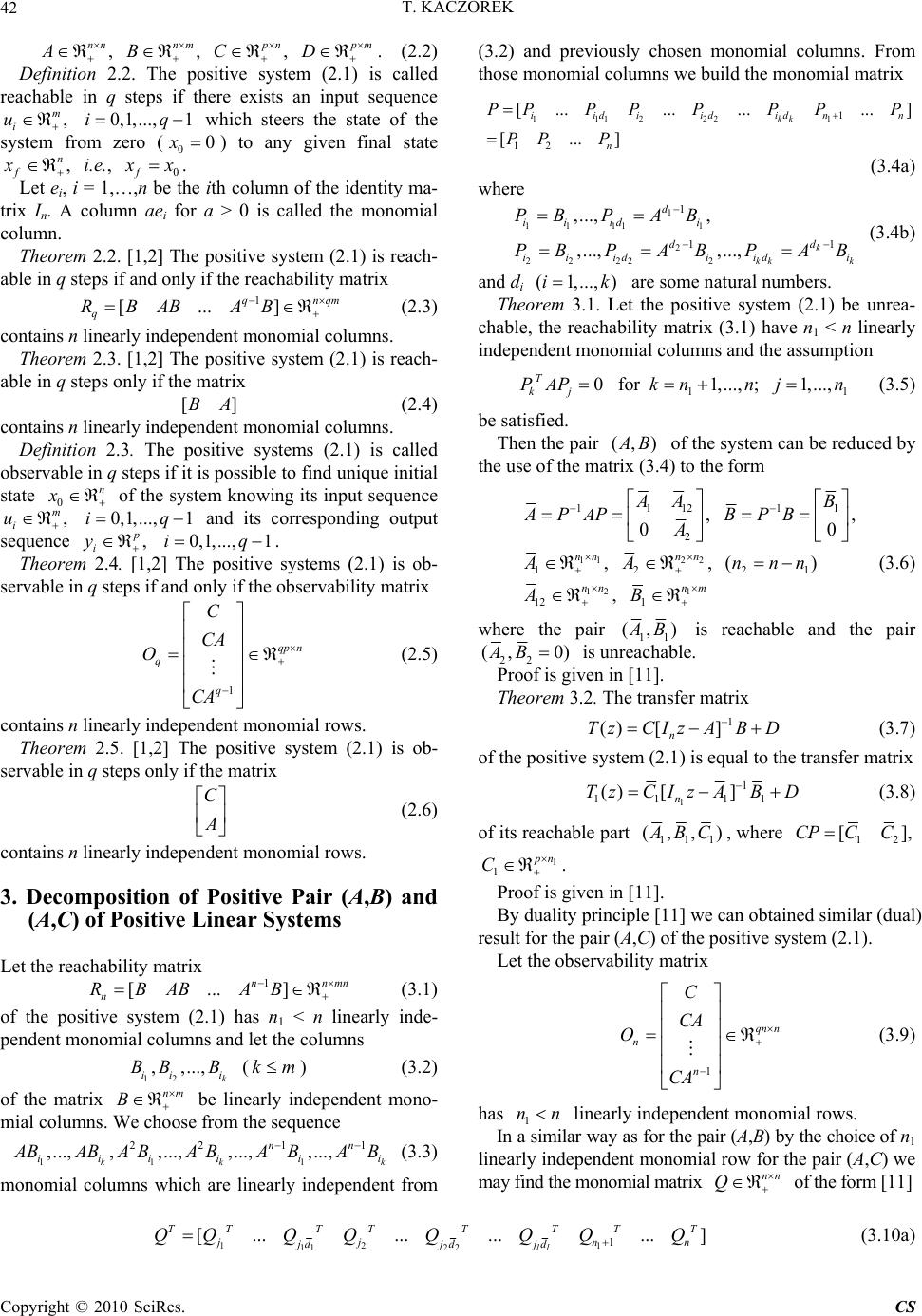 T. KACZOREK Copyright © 2010 SciRes. CS 42 ,,, nn nmpnpm AB CD . (2.2) Definition 2.2. The positive system (2.1) is called reachable in q steps if there exists an input sequence , m i u 0,1,..., 1iq which steers the state of the system from zero (00x) to any given final state , n f x i.e., 0f x x. Let ei, i = 1,…,n be the ith column of the identity ma- trix In. A column aei for a > 0 is called the monomial column. Theorem 2.2. [1,2] The positive system (2.1) is reach- able in q steps if and only if the reachability matrix 1 [...] qnqm q RBAB AB (2.3) contains n linearly independent monomial columns. Theorem 2.3. [1,2] The positive system (2.1) is reach- able in q steps only if the matrix ][ AB (2.4) contains n linearly independent monomial columns. Definition 2.3. The positive systems (2.1) is called observable in q steps if it is possible to find unique initial state 0 n x of the system knowing its input sequence , m i u 0,1,..., 1iq and its corresponding output sequence , p i y 0,1,..., 1iq . Theorem 2.4. [1,2] The positive systems (2.1) is ob- servable in q steps if and only if the observability matrix 1 qp n q q C CA O CA (2.5) contains n linearly independent monomial rows. Theorem 2.5. [1,2] The positive system (2.1) is ob- servable in q steps only if the matrix C A (2.6) contains n linearly independent monomial rows. 3. Decomposition of Positive Pair (A,B) and (A,C) of Positive Linear Systems Let the reachability matrix 1 [...] nnmn n RBAB AB (3.1) of the positive system (2.1) has n1 < n linearly inde- pendent monomial columns and let the columns 12 ,,..., k iii BBB (km) (3.2) of the matrix nm B be linearly independent mono- mial columns. We choose from the sequence 11 1 221 1 ,..., ,,...,,...,,..., kk k nn iii iii A BABABABABAB (3.3) monomial columns which are linearly independent from (3.2) and previously chosen monomial columns. From those monomial columns we build the monomial matrix 1112 221 1 12 [............ ] [... ] kk iidi ididnn n P PPPP PPP PP P (3.4a) where 1 11 111 2 22 222 1 1 1 ,..., , ,...,,..., k kk k d ii idi d d ii idi idi PB PAB PB PABPAB (3.4b) and di (1,..., )ik are some natural numbers. Theorem 3.1. Let the positive system (2.1) be unrea- chable, the reachability matrix (3.1) have n1 < n linearly independent monomial columns and the assumption 11 0 for 1,...,;1,..., T kj PAPknnjn (3.5) be satisfied. Then the pair (,) A B of the system can be reduced by the use of the matrix (3.4) to the form 112 2 12 1 11 112 1 2 12 21 12 1 ,, 00 ,,() , nnnn nn nm AA B APAPBPB A AA nnn AB (3.6) where the pair 11 (,) A B is reachable and the pair 22 (, 0)AB is unreachable. Proof is given in [11]. Theorem 3.2. The transfer matrix 1 () [] n TzCIz AB D (3.7) of the positive system (2.1) is equal to the transfer matrix 1 1 11 11 () [] n TzCIz ABD (3.8) of its reachable part 111 (,,) A BC , where 12 [],CPC C 1 1 p n C . Proof is given in [11]. By duality principle [11] we can obtained similar (dual) result for the pair (A,C) of the positive system (2.1). Let the observability matrix 1 qn n n n C CA O CA (3.9) has 1 nn linearly independent monomial rows. In a similar way as for the pair (A,B) by the choice of n1 linearly independent monomial row for the pair (A,C) we may find the monomial matrix nn Q of the form [11] 12 1 112 21 [............ ] ll TT TTT TTT jj nn jdj djd QQQ QQQ QQ (3.10a) 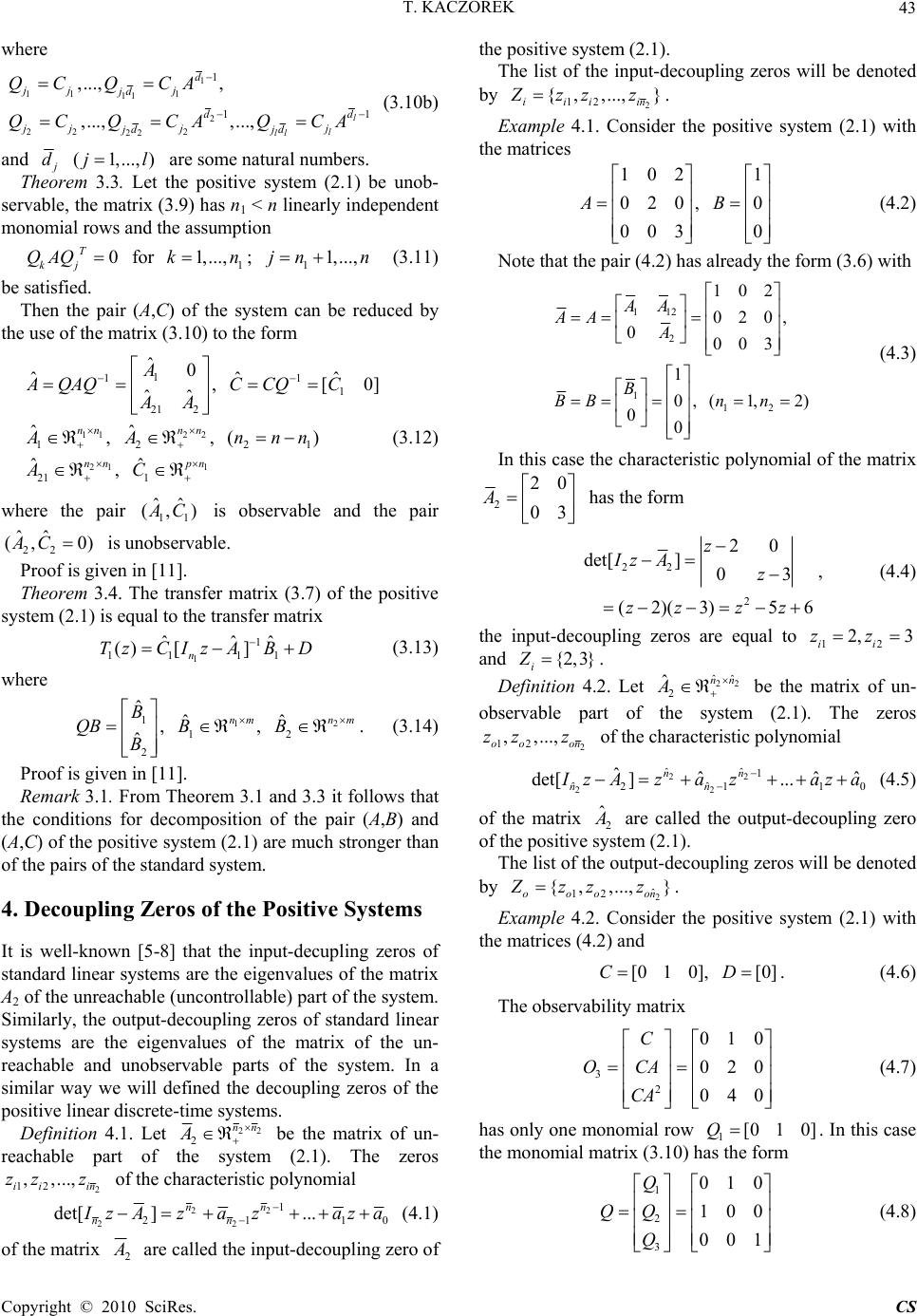 T. KACZOREK Copyright © 2010 SciRes. CS 43 where 1 11 1 11 2 22 2 22 1 1 1 ,..., , ,...,,..., l l ll d jj j jd d d jj jj jd jd QC QCA QC QCAQCA (3.10b) and (1,..., ) j dj l are some natural numbers. Theorem 3.3. Let the positive system (2.1) be unob- servable, the matrix (3.9) has n1 < n linearly independent monomial rows and the assumption 0 T kj QAQ for 1 1,...,kn; 11,...,jn n (3.11) be satisfied. Then the pair (A,C) of the system can be reduced by the use of the matrix (3.10) to the form 112 2 21 1 1 11 1 21 2 12 21 21 1 ˆ0 ˆˆˆ ,[0] ˆˆ ˆˆ ,,() ˆˆ , nnnn nn pn A AQAQCCQC AA AA nnn AC (3.12) where the pair 11 ˆˆ (, ) A C is observable and the pair 22 ˆˆ (, 0)AC is unobservable. Proof is given in [11]. Theorem 3.4. The transfer matrix (3.7) of the positive system (2.1) is equal to the transfer matrix 1 1 11 11 ˆˆ ˆ () [] n TzCIz ABD (3.13) where 12 1 12 2 ˆˆˆ ,, ˆ nmn m B QB BB B . (3.14) Proof is given in [11]. Remark 3.1. From Theorem 3.1 and 3.3 it follows that the conditions for decomposition of the pair (A,B) and (A,C) of the positive system (2.1) are much stronger than of the pairs of the standard system. 4. Decoupling Zeros of the Positive Systems It is well-known [5-8] that the input-decupling zeros of standard linear systems are the eigenvalues of the matrix A2 of the unreachable (uncontrollable) part of the system. Similarly, the output-decoupling zeros of standard linear systems are the eigenvalues of the matrix of the un- reachable and unobservable parts of the system. In a similar way we will defined the decoupling zeros of the positive linear discrete-time systems. Definition 4.1. Let 22 2 nn A be the matrix of un- reachable part of the system (2.1). The zeros 2 12 , ,..., ii in zz z of the characteristic polynomial 22 22 1 2110 det[ ]... nn nn I zAza zaza (4.1) of the matrix 2 A are called the input-decoupling zero of the positive system (2.1). The list of the input-decoupling zeros will be denoted by 2 12 {, ,...,} iii in Z zz z. Example 4.1. Consider the positive system (2.1) with the matrices 102 1 020, 0 003 0 AB (4.2) Note that the pair (4.2) has already the form (3.6) with 112 2 1 12 102 020, 0003 1 0, (1,2) 00 AA AA A B BBnn (4.3) In this case the characteristic polynomial of the matrix 2 20 03 A has the form 22 2 20 det[]03 ( 2 )( 3 ) 56 z Iz Az zz zz , (4.4) the input-decoupling zeros are equal to 12 2, 3 ii zz and {2, 3} i Z . Definition 4.2. Let 22 ˆˆ 2 ˆnn A be the matrix of un- observable part of the system (2.1). The zeros 2 12 , ,..., oo on zz z of the characteristic polynomial 22 22 ˆˆ 1 ˆˆ 2110 ˆˆˆˆ det[ ]... nn nn I zAza zaza (4.5) of the matrix 2 ˆ A are called the output-decoupling zero of the positive system (2.1). The list of the output-decoupling zeros will be denoted by 2 ˆ 12 { ,,...,} oooon Z zz z. Example 4.2. Consider the positive system (2.1) with the matrices (4.2) and [0 1 0],[0]CD . (4.6) The observability matrix 3 2 010 020 040 C OCA CA (4.7) has only one monomial row 1[010]Q. In this case the monomial matrix (3.10) has the form 1 2 3 010 100 001 Q QQ Q (4.8) 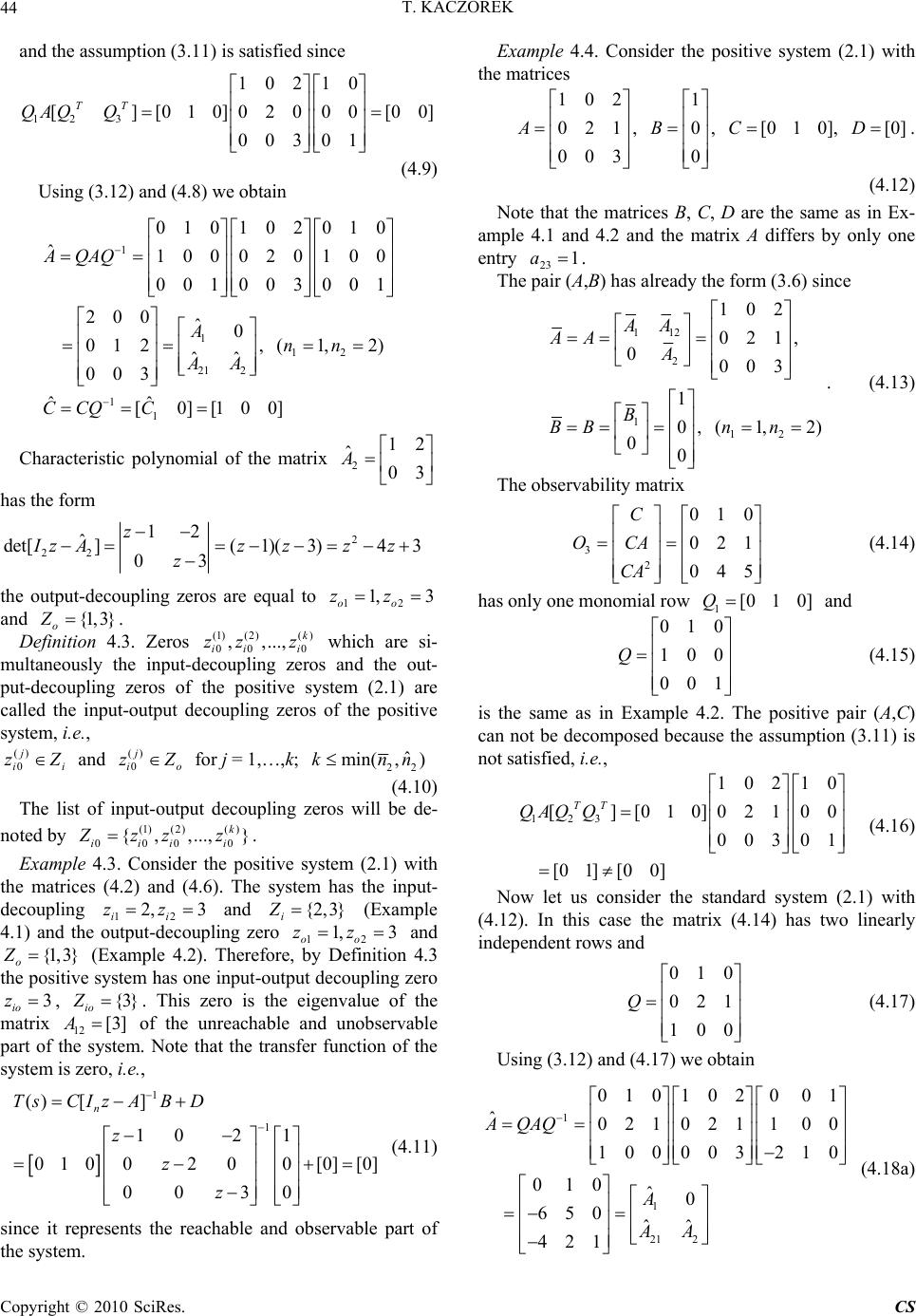 T. KACZOREK Copyright © 2010 SciRes. CS 44 and the assumption (3.11) is satisfied since 12 3 10210 [][010]02000 [00] 00301 TT QAQ Q (4.9) Using (3.12) and (4.8) we obtain 1 1 12 21 2 1 1 01010 2010 ˆ100020100 001003001 200 ˆ0 012,( 1,2) ˆˆ 003 ˆˆ [0][100] AQAQ Ann AA CCQC Characteristic polynomial of the matrix 2 12 ˆ 03 A has the form 2 22 12 ˆ det[]( 1)(3)43 03 z Iz Azzzz z the output-decoupling zeros are equal to 12 1, 3 oo zz and {1, 3} o Z. Definition 4.3. Zeros (1)(2)( ) 00 0 ,,..., k ii i zzz which are si- multaneously the input-decoupling zeros and the out- put-decoupling zeros of the positive system (2.1) are called the input-output decoupling zeros of the positive system, i.e., i j iZz )( 0 and () 0 j io zZ for j = 1,…,k; 22 ˆ min( ,) knn (4.10) The list of input-output decoupling zeros will be de- noted by (1)(2)() 000 0 { ,,...,} k iii i Z zz z. Example 4.3. Consider the positive system (2.1) with the matrices (4.2) and (4.6). The system has the input- decoupling 12 2, 3 ii zz and {2, 3} i Z (Example 4.1) and the output-decoupling zero 12 1, 3 oo zz and {1, 3} o Z (Example 4.2). Therefore, by Definition 4.3 the positive system has one input-output decoupling zero 3 io z, {3} io Z. This zero is the eigenvalue of the matrix 12 [3]A of the unreachable and unobservable part of the system. Note that the transfer function of the system is zero, i.e., 1 1 () [] 1021 0100200 [0][0] 00 30 n TsCIzABD z z z (4.11) since it represents the reachable and observable part of the system. Example 4.4. Consider the positive system (2.1) with the matrices 102 1 021,0 ,[010],[0] 003 0 ABCD . (4.12) Note that the matrices B, C, D are the same as in Ex- ample 4.1 and 4.2 and the matrix A differs by only one entry 1 23 a. The pair (A,B) has already the form (3.6) since 112 2 1 12 102 021, 0003 1 0, (1,2) 00 AA AA A B BBn n . (4.13) The observability matrix 3 2 010 021 045 C OCA CA (4.14) has only one monomial row 1[0 1 0]Q and 010 100 001 Q (4.15) is the same as in Example 4.2. The positive pair (A,C) can not be decomposed because the assumption (3.11) is not satisfied, i.e., 123 10210 [ ][010]02100 00301 [0 1][00] TT QAQQ (4.16) Now let us consider the standard system (2.1) with (4.12). In this case the matrix (4.14) has two linearly independent rows and 010 021 100 Q (4.17) Using (3.12) and (4.17) we obtain 1 1 21 2 0101020 01 ˆ0210211 00 100003 210 010 ˆ0 650 ˆˆ 421 AQAQ A AA (4.18a) 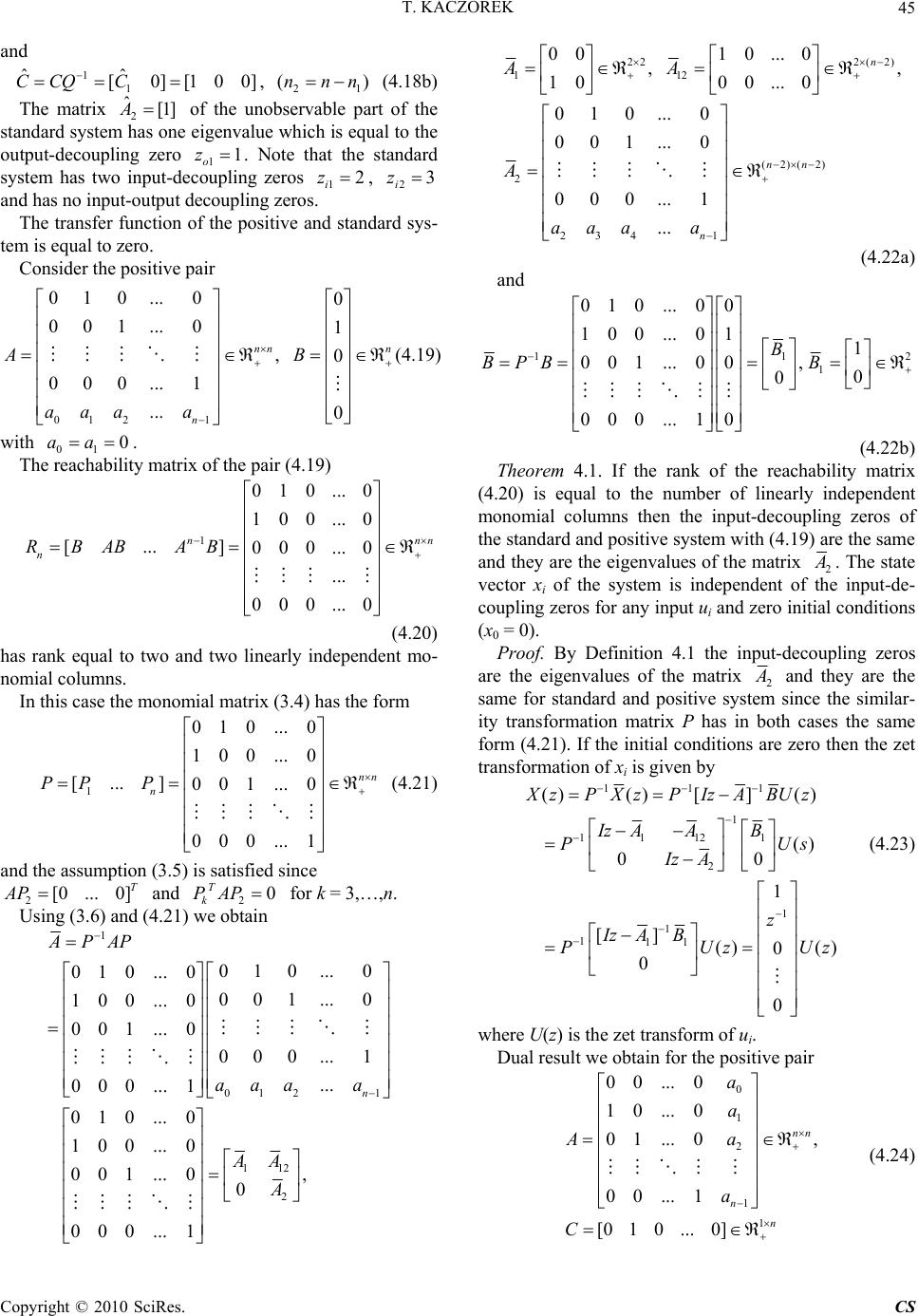 T. KACZOREK Copyright © 2010 SciRes. CS 45 and 1 1 ˆˆ [0][100] CCQC , 21 ()nnn (4.18b) The matrix 2 ˆ[1] A of the unobservable part of the standard system has one eigenvalue which is equal to the output-decoupling zero 11 o z. Note that the standard system has two input-decoupling zeros 12 i z, 3 2 i z and has no input-output decoupling zeros. The transfer function of the positive and standard sys- tem is equal to zero. Consider the positive pair 012 1 010... 00 001... 01 ,0 000... 1 ... 0 nn n n AB aaa a (4.19) with 01 0aa. The reachability matrix of the pair (4.19) 1 010...0 100...0 [...] 000...0 ... 000...0 nnn n RBAB AB (4.20) has rank equal to two and two linearly independent mo- nomial columns. In this case the monomial matrix (3.4) has the form 1 010...0 100...0 [...] 001...0 000...1 nn n PP P (4.21) and the assumption (3.5) is satisfied since 2[0 ... 0]T AP and 20 T k PAP for k = 3,…,n. Using (3.6) and (4.21) we obtain 1 012 1 112 2 010 ...0 0 1 0...0 001 ...0 1 00... 0 0 0 1...0 000 ...1 ... 000...1 010...0 100...0 , 001...0 0 000 ...1 n APAP aaa a AA A 222( 2) 112 (2)(2) 2 2341 00 10...0 ,, 10 00...0 010... 0 001... 0 000... 1 ... n nn n AA A aaa a (4.22a) and 1 2 1 1 010...00 100...011 , 001...00 0 0 000...10 B BPB B (4.22b) Theorem 4.1. If the rank of the reachability matrix (4.20) is equal to the number of linearly independent monomial columns then the input-decoupling zeros of the standard and positive system with (4.19) are the same and they are the eigenvalues of the matrix 2 A . The state vector xi of the system is independent of the input-de- coupling zeros for any input ui and zero initial conditions (x0 = 0). Proof. By Definition 4.1 the input-decoupling zeros are the eigenvalues of the matrix 2 A and they are the same for standard and positive system since the similar- ity transformation matrix P has in both cases the same form (4.21). If the initial conditions are zero then the zet transformation of xi is given by 111 1 1112 1 2 1 1 111 ()()[]() () 00 1 [] () () 0 0 0 XzPXzP IzA BUz Iz AAB PUs Iz A z Iz AB PUzUz (4.23) where U(z) is the zet transform of ui. Dual result we obtain for the positive pair 0 1 2 1 1 00...0 10...0 01...0 , 00...1 [0 1 0...0] nn n n a a Aa a C (4.24) 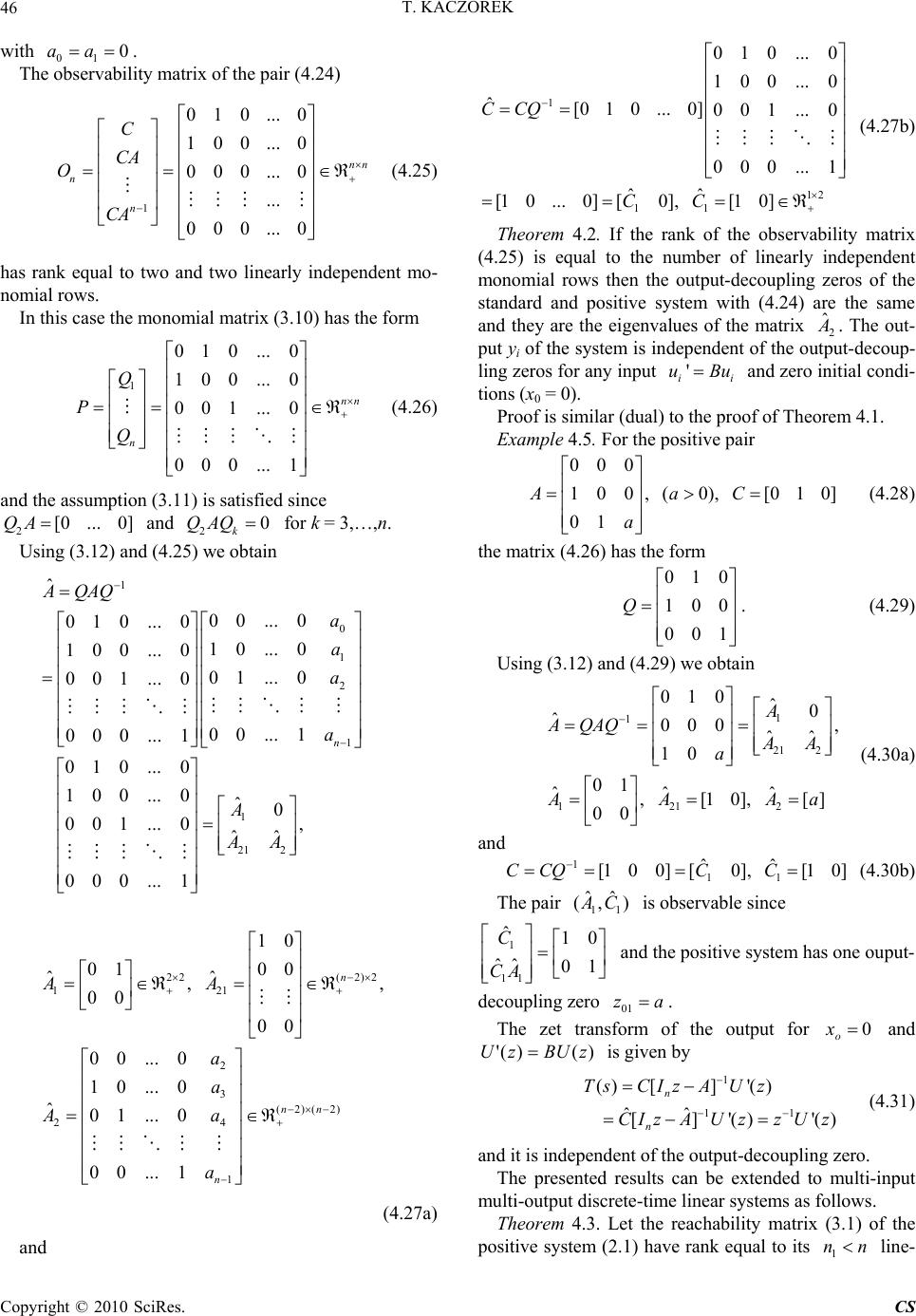 T. KACZOREK Copyright © 2010 SciRes. CS 46 with 01 0aa. The observability matrix of the pair (4.24) 1 010...0 100...0 000...0 ... 000...0 nn n n C CA O CA (4.25) has rank equal to two and two linearly independent mo- nomial rows. In this case the monomial matrix (3.10) has the form 1 010...0 100...0 001...0 000...1 nn n Q P Q (4.26) and the assumption (3.11) is satisfied since 2[0 ... 0]QA and 20 k QAQ for k = 3,…,n. Using (3.12) and (4.25) we obtain 1 0 1 2 1 1 21 2 1 ˆ 00...0 0 1 0...0 10...0 1 00... 0 01...0 0 0 1...0 00...1 000...1 010...0 100...0 ˆ0, 001...0 ˆˆ 000 ...1 01 ˆ 00 n AQAQ a a a a A AA A 22( 2)2 21 2 3 (2)(2) 24 1 10 00 ˆ ,, 00 00...0 10...0 ˆ01...0 00...1 n nn n A a a Aa a (4.27a) and 1 12 11 010...0 100...0 ˆ[010...0] 001... 0 000...1 ˆˆ [1 0 ...0][0],[10] CCQ CC (4.27b) Theorem 4.2. If the rank of the observability matrix (4.25) is equal to the number of linearly independent monomial rows then the output-decoupling zeros of the standard and positive system with (4.24) are the same and they are the eigenvalues of the matrix 2 ˆ A . The out- put yi of the system is independent of the output-decoup- ling zeros for any input ' ii uBu and zero initial condi- tions (x0 = 0). Proof is similar (dual) to the proof of Theorem 4.1. Example 4.5. For the positive pair 000 100,( 0),[010] 01 AaC a (4.28) the matrix (4.26) has the form 010 100 001 Q . (4.29) Using (3.12) and (4.29) we obtain 1 1 21 2 1212 010 ˆ0 ˆ000 , ˆˆ 10 01 ˆˆˆ ,[10],[] 00 A AQAQ A A a A AAa (4.30a) and 1 11 ˆˆ [1 00][0],[10]CCQCC (4.30b) The pair 11 ˆˆ (, ) A C is observable since 1 11 ˆ10 ˆˆ 01 C CA and the positive system has one ouput- decoupling zero 01 za . The zet transform of the output for 0 o x and )()(' zBUzU is given by 1 11 ()[] '() ˆˆ []'() '() n n TsCIzAU z CIzAUzz Uz (4.31) and it is independent of the output-decoupling zero. The presented results can be extended to multi-input multi-output discrete-time linear systems as follows. Theorem 4.3. Let the reachability matrix (3.1) of the positive system (2.1) have rank equal to its 1 nn line- 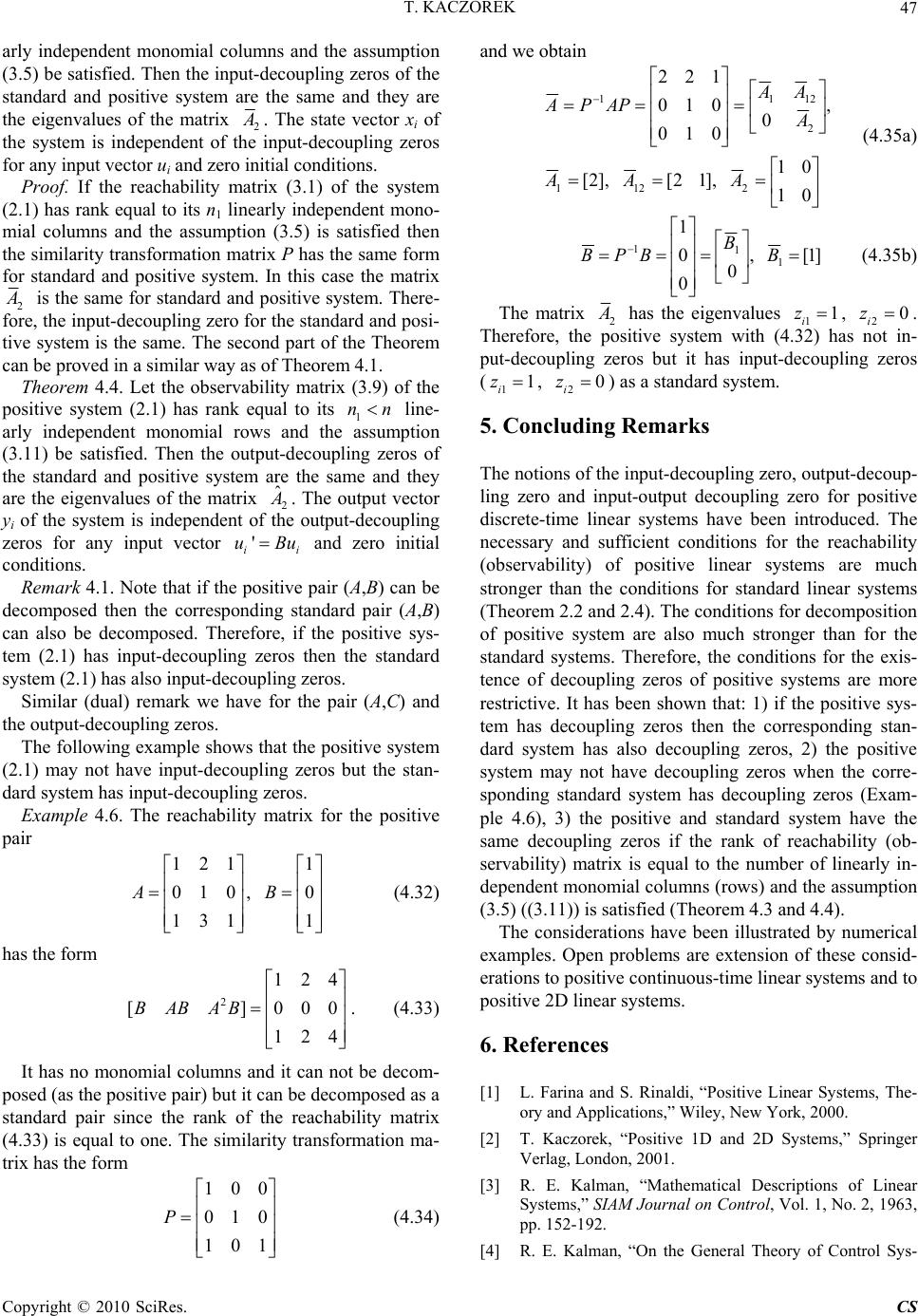 T. KACZOREK Copyright © 2010 SciRes. CS 47 arly independent monomial columns and the assumption (3.5) be satisfied. Then the input-decoupling zeros of the standard and positive system are the same and they are the eigenvalues of the matrix 2 A . The state vector xi of the system is independent of the input-decoupling zeros for any input vector ui and zero initial conditions. Proof. If the reachability matrix (3.1) of the system (2.1) has rank equal to its n1 linearly independent mono- mial columns and the assumption (3.5) is satisfied then the similarity transformation matrix P has the same form for standard and positive system. In this case the matrix 2 A is the same for standard and positive system. There- fore, the input-decoupling zero for the standard and posi- tive system is the same. The second part of the Theorem can be proved in a similar way as of Theorem 4.1. Theorem 4.4. Let the observability matrix (3.9) of the positive system (2.1) has rank equal to its 1 nn line- arly independent monomial rows and the assumption (3.11) be satisfied. Then the output-decoupling zeros of the standard and positive system are the same and they are the eigenvalues of the matrix 2 ˆ A . The output vector yi of the system is independent of the output-decoupling zeros for any input vector ' ii uBu and zero initial conditions. Remark 4.1. Note that if the positive pair (A,B) can be decomposed then the corresponding standard pair (A,B) can also be decomposed. Therefore, if the positive sys- tem (2.1) has input-decoupling zeros then the standard system (2.1) has also input-decoupling zeros. Similar (dual) remark we have for the pair (A,C) and the output-decoupling zeros. The following example shows that the positive system (2.1) may not have input-decoupling zeros but the stan- dard system has input-decoupling zeros. Example 4.6. The reachability matrix for the positive pair 121 1 010,0 131 1 AB (4.32) has the form 2 124 [] 000 124 BABAB . (4.33) It has no monomial columns and it can not be decom- posed (as the positive pair) but it can be decomposed as a standard pair since the rank of the reachability matrix (4.33) is equal to one. The similarity transformation ma- trix has the form 100 010 101 P (4.34) and we obtain 01 01 ],12[],2[ , 0 010 010 122 2121 2 121 1 AAA A AA APPA (4.35a) ]1[, 0 0 0 1 1 1 1 B B BPB (4.35b) The matrix 2 A has the eigenvalues 11 i z, 20 i z . Therefore, the positive system with (4.32) has not in- put-decoupling zeros but it has input-decoupling zeros (11 i z , 20 i z ) as a standard system. 5. Concluding Remarks The notions of the input-decoupling zero, output-decoup- ling zero and input-output decoupling zero for positive discrete-time linear systems have been introduced. The necessary and sufficient conditions for the reachability (observability) of positive linear systems are much stronger than the conditions for standard linear systems (Theorem 2.2 and 2.4). The conditions for decomposition of positive system are also much stronger than for the standard systems. Therefore, the conditions for the exis- tence of decoupling zeros of positive systems are more restrictive. It has been shown that: 1) if the positive sys- tem has decoupling zeros then the corresponding stan- dard system has also decoupling zeros, 2) the positive system may not have decoupling zeros when the corre- sponding standard system has decoupling zeros (Exam- ple 4.6), 3) the positive and standard system have the same decoupling zeros if the rank of reachability (ob- servability) matrix is equal to the number of linearly in- dependent monomial columns (rows) and the assumption (3.5) ((3.11)) is satisfied (Theorem 4.3 and 4.4). The considerations have been illustrated by numerical examples. Open problems are extension of these consid- erations to positive continuous-time linear systems and to positive 2D linear systems. 6. References [1] L. Farina and S. Rinaldi, “Positive Linear Systems, The- ory and Applications,” Wiley, New York, 2000. [2] T. Kaczorek, “Positive 1D and 2D Systems,” Springer Verlag, London, 2001. [3] R. E. Kalman, “Mathematical Descriptions of Linear Systems,” SIAM Journal on Control, Vol. 1, No. 2, 1963, pp. 152-192. [4] R. E. Kalman, “On the General Theory of Control Sys- 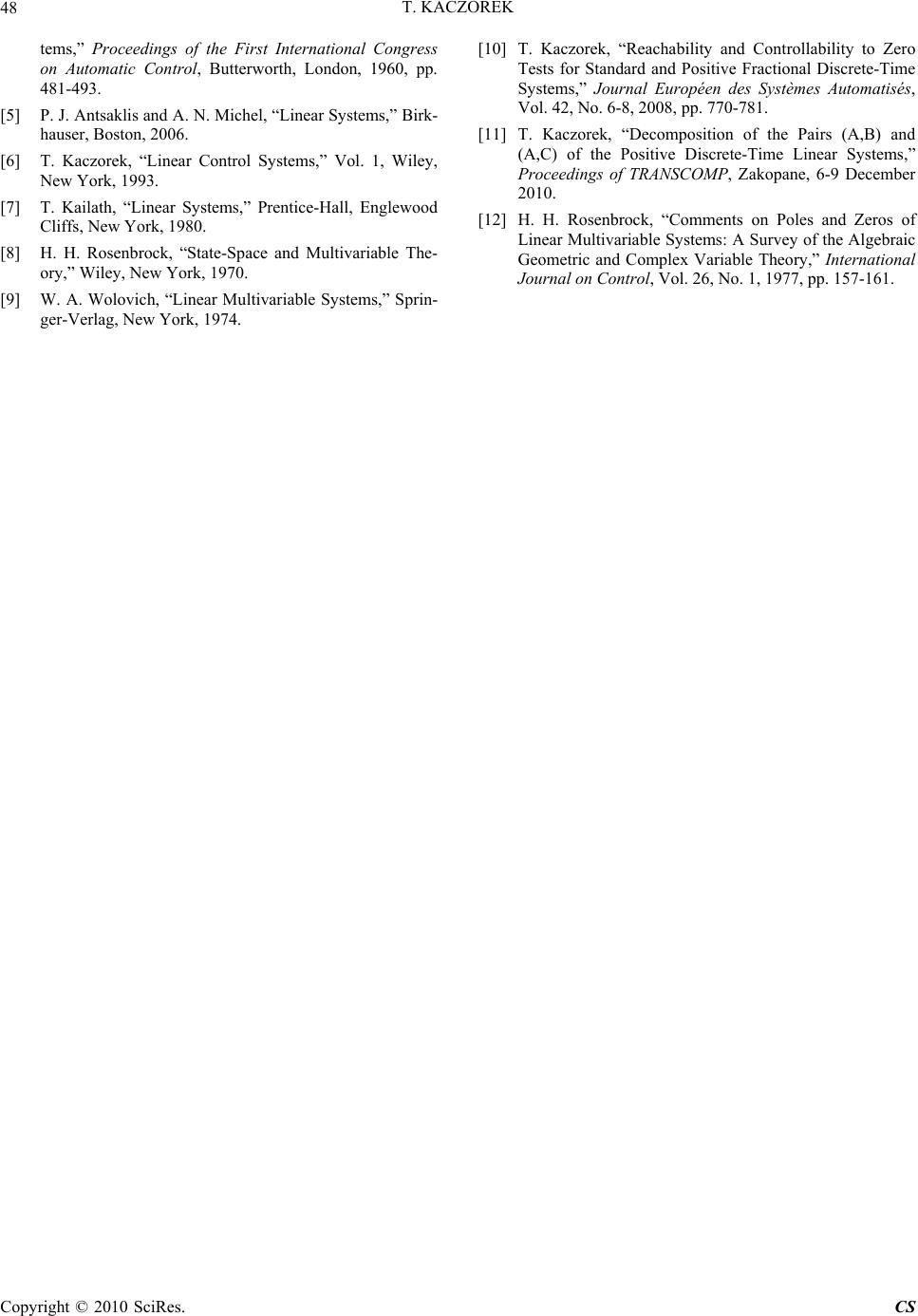 T. KACZOREK Copyright © 2010 SciRes. CS 48 tems,” Proceedings of the First International Congress on Automatic Control, Butterworth, London, 1960, pp. 481-493. [5] P. J. Antsaklis and A. N. Michel, “Linear Systems,” Birk- hauser, Boston, 2006. [6] T. Kaczorek, “Linear Control Systems,” Vol. 1, Wiley, New York, 1993. [7] T. Kailath, “Linear Systems,” Prentice-Hall, Englewood Cliffs, New York, 1980. [8] H. H. Rosenbrock, “State-Space and Multivariable The- ory,” Wiley, New York, 1970. [9] W. A. Wolovich, “Linear Multivariable Systems,” Sprin- ger-Verlag, New York, 1974. [10] T. Kaczorek, “Reachability and Controllability to Zero Tests for Standard and Positive Fractional Discrete-Time Systems,” Journal Européen des Systèmes Automatisés, Vol. 42, No. 6-8, 2008, pp. 770-781. [11] T. Kaczorek, “Decomposition of the Pairs (A,B) and (A,C) of the Positive Discrete-Time Linear Systems,” Proceedings of TRANSCOMP, Zakopane, 6-9 December 2010. [12] H. H. Rosenbrock, “Comments on Poles and Zeros of Linear Multivariable Systems: A Survey of the Algebraic Geometric and Complex Variable Theory,” International Journal on Control, Vol. 26, No. 1, 1977, pp. 157-161. |

